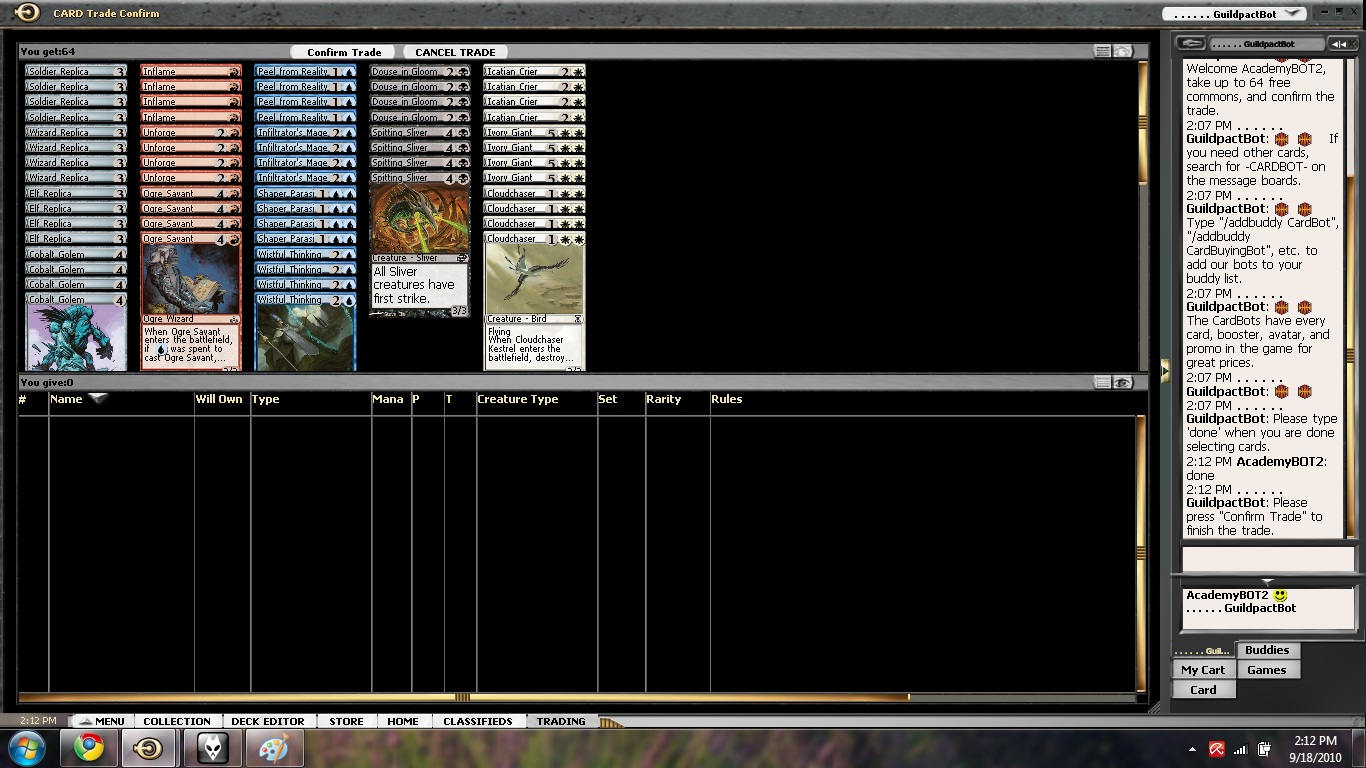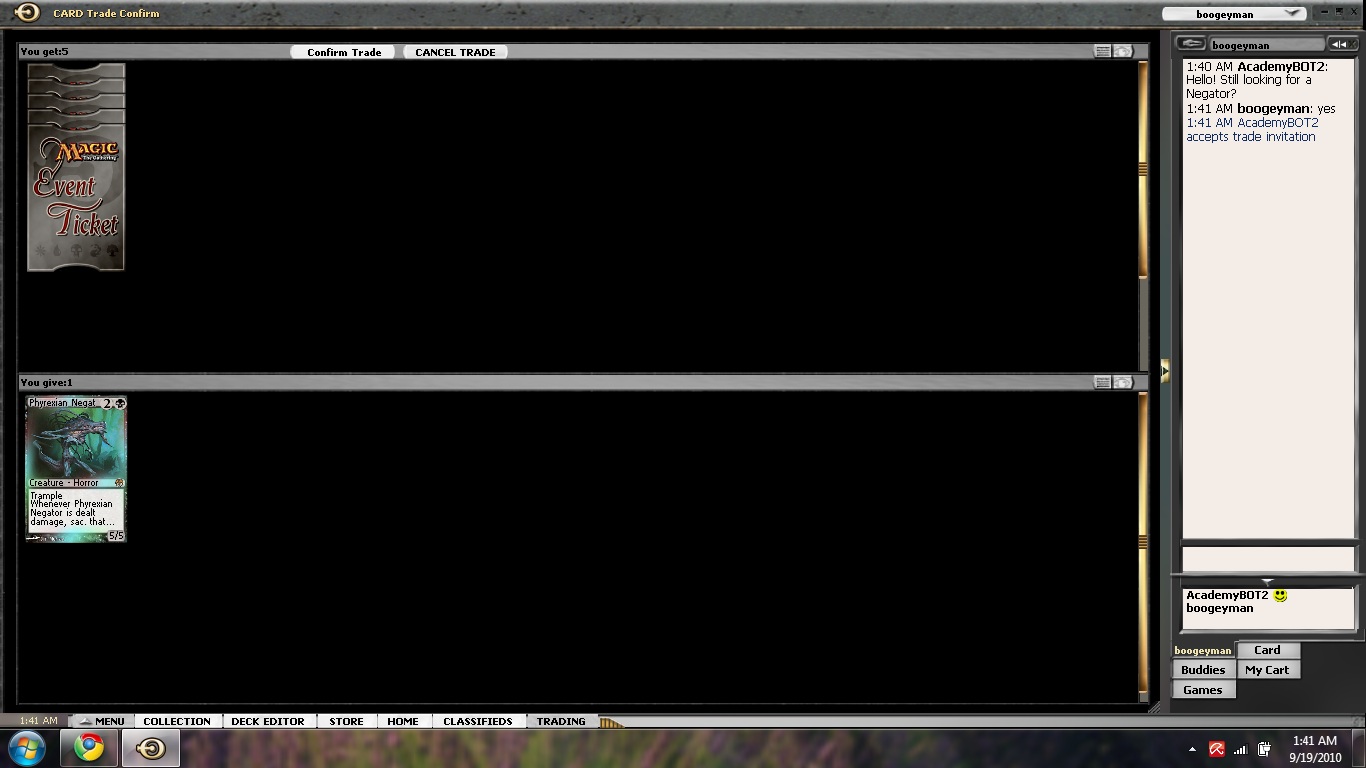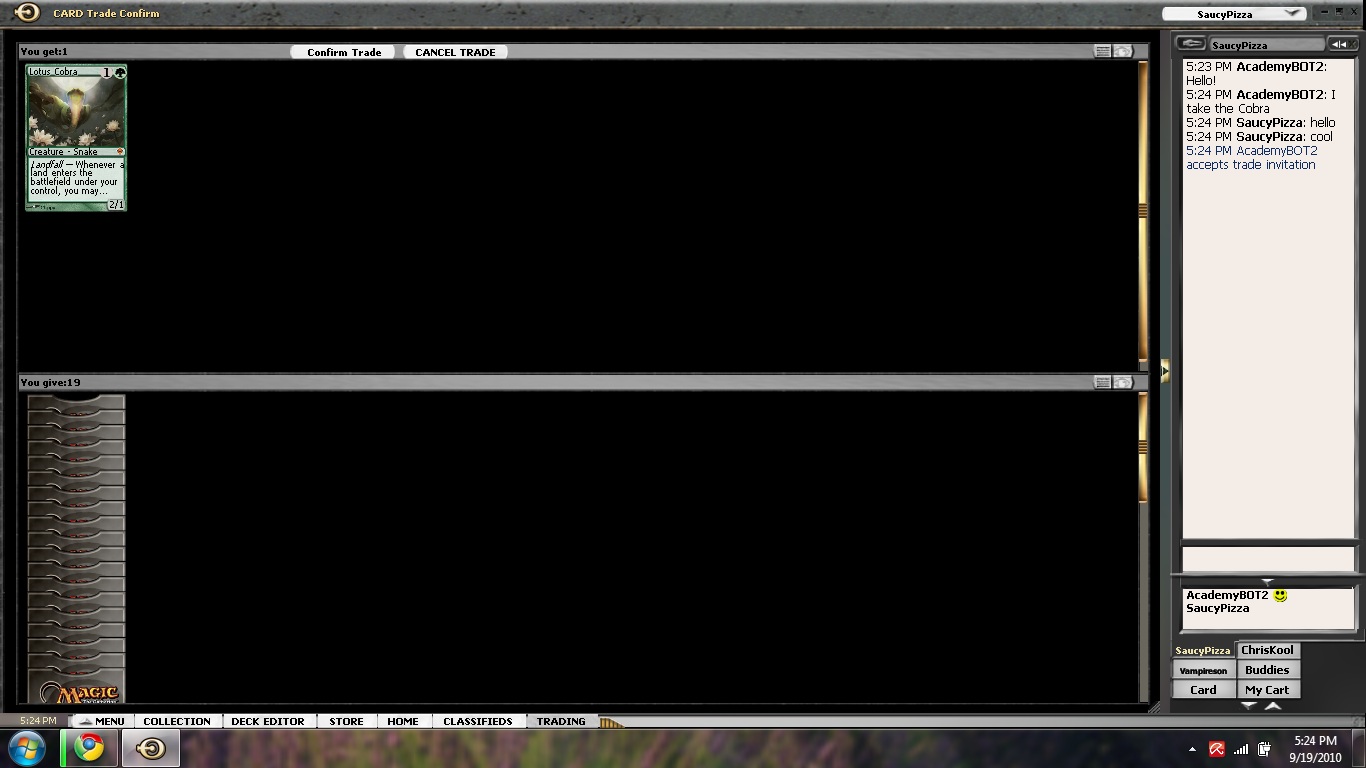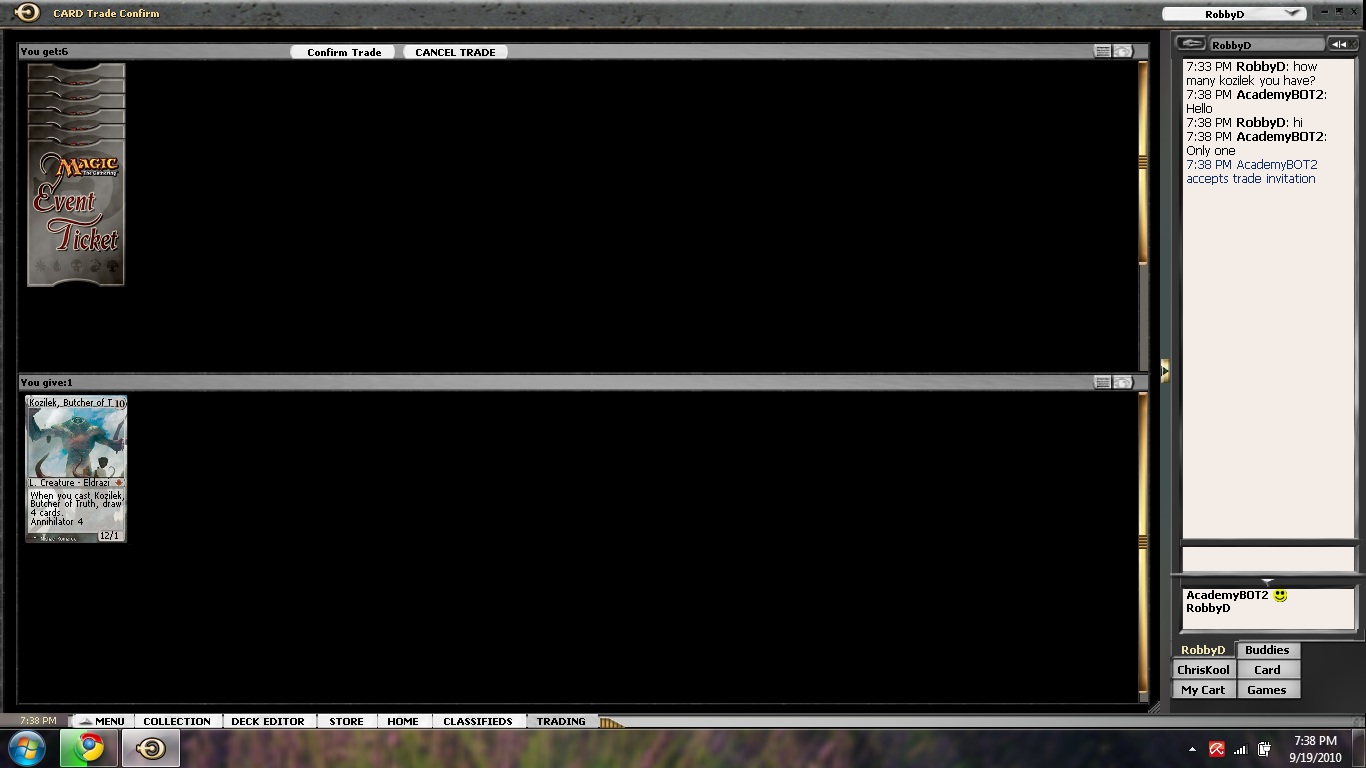Welcome folks,
I have a few more trades for you today, followed by a breakdown of collection value. As usual, I started by continuing the tradition of checking all the “Freebots” (the ones that give away 64 commons). It’s not much value, but if you continuously take the free material, you can build up a selection of cards to sweeten a deal or make it look better with some extra throw ins.
While I was collecting commons and working on some unrelated stuff, I noticed someone that was interested in buying a foil Phyrexian Negator (regular readers know how long I have been carrying this guy around…)! I was glad that I could sell this low demand foil for a decent price- I can use the tickets.
While scanning the board to make use of my tickets, I saw a player selling 6x M11 foil duals for 6 tickets. While this is certainly not the deal of the month, it is a very fair price for cards I believe will gain some value after rotation. I figured that there’s nothing to lose at 1 apiece- I could at least resell for a similar price to what I paid- but I could get a nice profit margin after Magic 2011 loses some popularity in the Limited queues. (Also, the seller recognized me as the “mtgoacademy guy” and we proceeded to have a nice chat about MTGO and card prices in general.)
After purchasing the foil real estate, I had a solid amount of staples (or cards that might become staples) mixed with a few speculative cards. (Foil Forks are still rather rare but hard to sell.) I do have more possibilities to buy and sell more expensive cards now due to my increased ticket count, which I did in my next purchase. I bought a Lotus Cobra for 19 tickets; it does not give me a huge margin potential, but the card is a very easy sell and should not clog my virtual binder for very long.
Finally I sold my Kozilek, Butcher of Truth to recoup some of the tickets that I spent today- you must remain liquid!
Generally speaking, it is useful to handle long turnaround/high profit margin cards if you have little to invest and short turnaround/low profit margin cards if you have a solid ticket stash. This is primarily because you can leverage the short turnaround cards much better with a lot of tickets. (By the way, this is one of the reasons that bots can operate with such tiny margins for some of the most popular cards. It is not unusual for bots to buy a card for 4.75 and sell for 5 if the card is highly popular- the small increments add up quickly when volume is there!)
I got a few requests from readers (and my chief editor who is constantly pushing for quality) to expand a bit on the collection value statistics. I decided to do just that, mainly because it shows another important concept- diminishing marginal utility.
This important economic principle basically states that every additional item of a commodity adds less value than the previous unit (there are exceptions to this, but they aren’t important for our purposes). In our concrete case, you can imagine that your first Lightning Bolt is very useful with each additional one being worth a bit less, and as soon as you hit five of the card, you have a big decline in value from a player’s perspective. This principle hits common cards especially hard. Yes, your 1172 Disenchants might be worth a Plateau in a sheer numbers comparison of value, but due to the diminishing utility, you will not find anyone making this trade. If you do, please let me know the person’s MTGO user name, as I would love to trade with him/her! This holds to a lesser extend true even for different items of the same bulk rarity level- your first 200 commons are much more useful for you than your 10,000th.
However, there are some extreme examples where the marginal utility goes down constantly and then when you continue to add items it jumps up again. Can anyone think of an example? Post it in the comments!
Why is this economical principle important for collection values? Quite simply speaking, it shows if the value in your collection is easy to turn into tix or if you are handling “phantom values.” If you value consists mainly of many duplicates of commons you will have a very hard time to cash out- just think of the previous example with Disenchants and the Plateau.
How does all of this apply to valuing the collection to we have accumulated? To make a long story short, I will now split the values of the collection into common/uncommon, rares/mythics and tickets (as I initially did), so that you can see that the majority of our collection value is not “phantom value.” Currently our collection distribution looks like this (all card values are computed using bot buying prices):
289 Commons/Uncommons – 3.3 tickets
30 Rares/Mythics – 64.4 tickets
31 Event Tickets
Total: 98.7 tickets
While it looks like there was not much of a change from last time, I think I made good progress getting rid of slow moving cards and increasing the amount of easy to sell staples. We shall see if I can make good progress with the next batch of trades! Hope you enjoyed the report and till next time,
Marin






Goodbye Negator!
Haha, what a deceptive excerpt. I am glad that I was able to sell some cards and the Negator was definitively an “old friend”.
I guess if you hoard enough of a card that is already in short supply, then it might seem like DMU does not apply, since once you have a monopoly or a pseudo-monopoly on the card, you are then a price maker rather than a price taker, and you can throw your weight around by selling the card at a higher price that you set.
However, this is deceptive since once you start selling your cards, you then lose your market power as the monopolist. The very people to whom you sold may decide to undercut you because you’ve set the price too high and there are supernormal profits to be made. You then run into the trouble of not being able to sell off your cards at your original high price, and therefore will be forced to lower your price by your competitors. Therefore hoarding exhibits symptoms of DMU too, and it’s rarely recommended since any supernormal profits you reap in the short run will then be cannibalised by your own selling.
NB: In this I’m defining “hoarding” to be buying enough of a card to be a price maker and have significant influence over the market, not just buying some cards and selling them later to make a profit – that’s simply speculation.
Hello Arthur,
while this strategy might work if you have tons of tickets to trade with I do not have the option to manipulate markets. I rather not do that in general even if I do have tix – sometimes I buy 15 or so of the same card if I see it cheap or believe that it will go up but usually I just try to find good deals.
In our case it’s a lot of speculation but educated guesses that mostly turn out well.
I like the breakdown of tix to rares/mythics. Are you going to become more liquid for the scars release, or are you looking to hold onto the rares/mythics you have in hopes they increase once rotation occurs?
I’m about the opposite to you at them moment (2:1 tix to rares) and looking forward to the rotation.
Another question – Terastodon, Thada Adel and Blade of the Bloodchief are all Zen block cards that have increased from bulk 0.1 tix prices to 0.5 or 1 tix. Do you see any other bulk cards worth speculating on? Splinter Twin has been kicked around for comboing with the Myr, but I’m not sure if any others will.
can’t believe this started out with just a new acct!
i know a lot of buddies who drive their accounts into nothingness fueled partly by losing in events but also because they are not savvy/decent/patient trader. this should be an inspiration to those guys (which i’ll link to here)
fueled partly by losing in events but also because they are not savvy/decent/patient trader. this should be an inspiration to those guys (which i’ll link to here)
can you smell the foily FOW? i can =) it’s close!
Relentless Rats might pick up in value once you have 20+ of them.
I’m curious do you have a method of what commons you do decide to pick form the freebots or do you pick randomly?
I usually just pick one ofs so I know the bots I sell them too will be more likely to buy them. Just reading your articles makes me want to play MTGO and do more trading.
some cards have value in high amounts. really bad cards like Chimney Imp or Tome Scour, or staple commons like Lightning Bolt or Brainstorm have a market of people collecting them.
back in the days (1998) or so I once got a arabian nights near mint juzam djinn for 320 laces (the laces were a cycle of 1 mana cards to change the color of a card, often called worst rares ever (at that time)
I was getting laces left and right, as it was known I was the crazy guy collecting laces. i thought i had a few at 300+. Until i got the mail from some guy (after I advertised them)
“Great, this will really help!’ He apperently had 937 laces at that time and offered the Juzam I was looking for. Of course in those days, it included a few alpha, beta and unlimited laces.